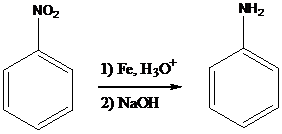
(a)
Interpretation: Major products for the given set of reactions have to be found.
Concept Introduction:
The nitro group present in the compound is reduced to amino group by using Fe, Zn, Sn or SnCl2 in the presence of aqueous acid followed by the treatment with base such as NaOH. This reaction is more mild approach. It can be carried out in the presence of the other

To find: Using a reduction followed by base treatment, prepare the major product of (a)
Find the reaction of the starting material of (a) with Fe, H3O+
(b)
Interpretation: Major products for the given set of reactions have to be found.
Concept Introduction:
Sodium cyanoborohydride is a strong reducing agent than sodium borohydride. It reduces the carbonyl group into amine group in a rapid way. So, it is called as reductive amination reactions.

Aldehyde or ketone group is reacted with primary amine in the presence of sodium cyanoborohydride as a reducing agent and a proton source in the reaction medium to produce secondary amines.

Aldehyde or ketone group is reacted with secondary amine in the presence of sodium cyanoborohydride as a reducing agent and a proton source in the reaction medium to produce tertiary amines.

To find: Using a reductive amination, prepare the major product of (b)
Decide the reaction and the nature of the product
(c)
Interpretation: Major products for the given set of reactions have to be found.
Concept introduction:
The reduction of lithium aluminum hydride on nitriles followed by water work-up gives amine with an additional carbon atom in their chain. This type of reaction is applied to increase the carbon skeleton and change in the identity of the functional group.
To find: The major product of the reaction (c)
Give for the formation of lithium salt by reduction

(d)
Interpretation: Major products for the given set of reactions have to be found.
Concept introduction:
The reduction of lithium aluminum hydride on nitriles followed by water work-up gives amine with an additional carbon atom in their chain. This type of reaction is applied to increase the carbon skeleton and change in the identity of the functional group.
To find: The major product of the reaction (d)
Give for the formation of lithium ion by reduction
Want to see the full answer?
Check out a sample textbook solution
Chapter 22 Solutions
Organic Chemistry 3rd.ed. Klein Evaluation/desk Copy
- 2. 200 LOD For an unknown compound with a molecular ion of 101 m/z: a. Use the molecular ion to propose at least two molecular formulas. (show your work) b. What is the DU for each of your possible formulas? (show your work) C. Solve the structure and assign each of the following spectra. 8 6 4 2 (ppm) 150 100 50 ō (ppm) 4000 3000 2000 1500 1000 500 HAVENUMBERI-11arrow_forwardComplete the spectroscopy with structurearrow_forwardComplete the spectroscopy with structurearrow_forward
 ChemistryChemistryISBN:9781305957404Author:Steven S. Zumdahl, Susan A. Zumdahl, Donald J. DeCostePublisher:Cengage Learning
ChemistryChemistryISBN:9781305957404Author:Steven S. Zumdahl, Susan A. Zumdahl, Donald J. DeCostePublisher:Cengage Learning ChemistryChemistryISBN:9781259911156Author:Raymond Chang Dr., Jason Overby ProfessorPublisher:McGraw-Hill Education
ChemistryChemistryISBN:9781259911156Author:Raymond Chang Dr., Jason Overby ProfessorPublisher:McGraw-Hill Education Principles of Instrumental AnalysisChemistryISBN:9781305577213Author:Douglas A. Skoog, F. James Holler, Stanley R. CrouchPublisher:Cengage Learning
Principles of Instrumental AnalysisChemistryISBN:9781305577213Author:Douglas A. Skoog, F. James Holler, Stanley R. CrouchPublisher:Cengage Learning Organic ChemistryChemistryISBN:9780078021558Author:Janice Gorzynski Smith Dr.Publisher:McGraw-Hill Education
Organic ChemistryChemistryISBN:9780078021558Author:Janice Gorzynski Smith Dr.Publisher:McGraw-Hill Education Chemistry: Principles and ReactionsChemistryISBN:9781305079373Author:William L. Masterton, Cecile N. HurleyPublisher:Cengage Learning
Chemistry: Principles and ReactionsChemistryISBN:9781305079373Author:William L. Masterton, Cecile N. HurleyPublisher:Cengage Learning Elementary Principles of Chemical Processes, Bind...ChemistryISBN:9781118431221Author:Richard M. Felder, Ronald W. Rousseau, Lisa G. BullardPublisher:WILEY
Elementary Principles of Chemical Processes, Bind...ChemistryISBN:9781118431221Author:Richard M. Felder, Ronald W. Rousseau, Lisa G. BullardPublisher:WILEY





